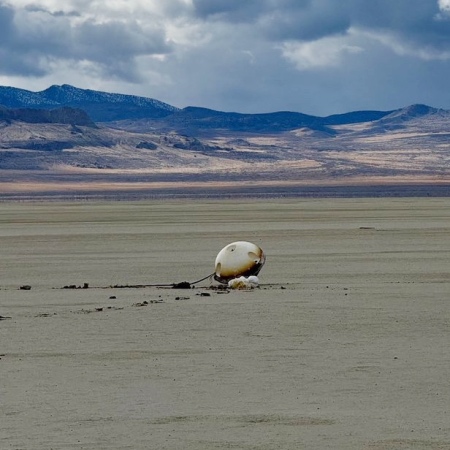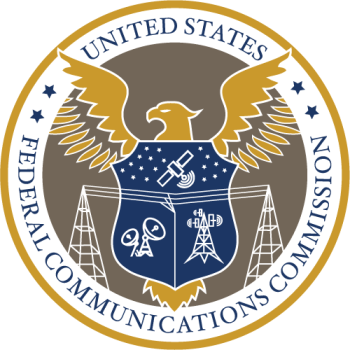Crosby Stills Nash – Judy Blue Eyes
An evening pause: Performed live 1969 at Woodstock.
Hat tip both Mike Nelson and Wayne DeVette, who separately suggested this one day apart.
An evening pause: Performed live 1969 at Woodstock.
Hat tip both Mike Nelson and Wayne DeVette, who separately suggested this one day apart.

Varda’s first capsule on the ground in Utah.
Rocket Lab today announced it has completed testing and intergration of a new recoverable capsule for the in-space manufacturing company Varda, to be used in orbit to produce pharmaceuticals that can only be created in weightlessness.
No launch date was announced. This was the second of four capsules Rocket Lab is building for Varda, with the first having already completed its flight, where it returned to Earth after successfully crystallizng the HIV drug Ritonavir.
The most important tidbit in the press release however was this:
Varda received permission from the FAA under a Part 450 license earlier this month, making them the only company to ever secure a second reentry license.
With the first capsule, the capsule’s return was delayed almost six months because the FAA and the military couldn’t get their paperwork together to approve the return license. Varda now has that return license in hand before launch, meaning it will get the capsule back when it wants.
According to SpaceX’s CEO, Gwynne Shotwell, during testimony in a hearing before the Texas state legislative committee and confirmed by a SpaceX tweet on X, Starlink now has a total of four million subscribers.
The milestone would mean that SpaceX has gained a million new customers since the end of May alone. This outpaces the company’s already impressive rate of growth: Starlink started providing beta service of its product in October 2020; it hit 1 million subscribers in December 2022, 2 million subscribers in September 2023, and 3 million in May. The constellation now comprises nearly 6,000 satellites, with service available in nearly 100 countries to individual users as well as large enterprise customers like major airlines and cruise lines.
The service is on track to generate $6.6 billion in revenue this year — an increase from roughly $1.4 billion just two years prior, according to industry research and consulting firm Quilty Space. [emphasis mine]
With $6.6 billion in yearly revenue, in two years SpaceX will get as much from its customers as it has raised in investment capital. It essentially does not need to look for more funding, as it is now earning enough to pay for both Starlink as well as the development of Starship/Superheavy. Furthermore, at this point the company no longer needs NASA’s government funds to do anything it wants to do.
Nor are these numbers the end. Yesterday it was also reported that Air France had signed up Starlink for its airplane fleet, coming after both United and Hawaiian airlines announced they were switching to Starlink as well.
No wonder the left as well as the federal bureaucracy — dominated by top-down authoritarians who love governemnt rule — are hostile to SpaceX. It no longer needs them, and that independence threatens their power.
The orbital tug company D-Orbit announced today that it was able to extend its more recent round of fund-raising by 50 million euros, and raise a total of 150 million in private investment capital instead.
Japan’s Marubeni Corp. led the Series C round. Marubeni has exclusive rights to distribute D-Orbit’s services in Japan in Southeast Asia, according to the news release.
New and existing investors participating in the round include: Avantgarde, CDP Venture Capital, Iberis Capital, Indaco Venture Partners, the European Innovation Council, Neva, Phaistos Investment Fund, Primo Ventures and Seraphim Space Investment Trust. Also joining the round was a consortium led by United Ventures that included the European Investment Bank and the European Investment Fund.
I call the company a “startup” in the headline, but that probably is now incorrect. It already has flown fourteen orbital tug missions, with seven more scheduled in 2025. At this point it is well established, and could extend this most recent funding round.

The EPA to SpaceX “Nice company you got here.
Sure would be a shame if something happened to it.”
In a follow-up to SpaceX’s blunt critical response to the attacks against it by the head of the FAA, Mike Whitaker during House testimony on September 24, 2024, Elon Musk in a tweet yesterday called for Whitaker to resign.
That blast however was only the start. During a different hearing on September 24th before the Texas state house appropriations committee, Gywnne Shotwell, the CEO of SpaceX, called the actions of the EPA to regulate the launch deluge system for Starship/Superheavy “nonsense.”
“We work very closely with organizations such as the (Texas Commission on Environmental Quality),” she said. “You may have read a little bit of nonsense in the papers recently about that, but we’re working quite well with them.”
…On Tuesday, Shotwell maintained that the the system — which she said resembles “an upside down shower head” — was “licensed and permitted by TCEQ [Texas Commission on Environmental Quality] … EPA came in afterwards and didn’t like the license or the permit that we had for that and wanted to turn it into a federal permit, which we are working on right now.”
…The state agency has said the company received a stormwater permit — a type that’s usually quickly approved — but did not have the permit required for discharge of industrial wastewater produced by launches. That type of permit requires significant technical review and usually takes almost a year to approve. [emphasis mine]
The problem with this demand by both EPA and TCEQ is that SpaceX is not dumping “industrial wastewater produced by launches.” The deluge system uses potable water, essentially equivalent to rain water, and thus does zero harm to the environment. In fact, a single rainstorm would dump far more water on the tidal islands of Boca Chica that any of SpaceX’s Starship/Superheavy launches.
Thus, this demand by the EPA clearly proves the political nature of this regulatory harassment. The unelected apparatchiks in the federal bureaucracy are hunting for ways to stymie and shut down SpaceX, and they will use any regulation they can find to do so — even if that use makes no sense. And they are doing this because they support the Democratic Party wholesale, and thus are abusing their power to hurt someone (Elon Musk) who now opposes that party.
Lunar Outpost, one of the three companies/partnerships that have won NASA contracts to develop manned lunar rovers for the Artemis program, has replaced Lockheed Martin as one of its partners.
This fact was only made evident now, three months after Lockheed parted ways, with a statement that a new much smaller company, Leidos, has joined the consortium.
That statement listed the other members of the Lunar Dawn team: General Motors, Goodyear and MDA Space. Notably absent was Lockheed Martin, which Lunar Outpost had described as its “principal partner” on the rover when it won the NASA contract in April. The website for Lunar Dawn also did not list Lockheed Martin as a partner.
In a Sept. 25 interview, Justin Cyrus, chief executive of Lunar Outpost, confirmed that Lockheed Martin was no longer involved in the rover project. “We just weren’t able to reach an agreement as we were negotiating the terms and conditions of the statement of work for this contract,” he said.
Both Lunar Outpost and Lockheed Martin provided no specific reasons for the break-up, other than typical PR statements such as “it wasn’t a good fit for us or them.”
The rover being built is dubbed Lunar Dawn. The present NASA contract only covers the design phase. Once completed NASA will choose one consortium to build the rover itself, picking from either the Lunar Outpost design or the designs submitted by Intuitive Machines and Venturi Astrolab.
With the release of a new space strategy document [pdf] today, it appears that New Zealand’s new government has abandoned a promise it had made during the election campaign to streamline its space licensing requirements.
It appears that the new leading party in the government had promised to eliminate the present complex licensing rules that require an entirely new license every time a rocket or satellite company makes any change in its plans. The new space strategy however makes no mention of this change, and in fact seems more focused on expanding the government’s reach into space operations, including building and launching its own satellite by 2030. The article at the link suggests this change is possibly because the leading party is in a coalition government that must satisfy its coalition partners.
Three years ago I would have said this policy change would have guaranteed that Rocket Lab would shift more operations to the U.S., but the increased red tape imposed by the FAA’s new “streamlined” Part 450 regulations doesn’t make such a shift helpful any longer. Since the UK government also appears to be favoring heavy regulations that have stalled spaceports there, these government actions might help explain why there has been a sudden burst of new rocket companies and spaceports in Europe and in India in the past two years. Private concerns in both sense an opportunity.
SpaceX tonight successfully launched another 21 Starlink satellites, its Falcon 9 rocket lifting off from Vandenberg in California.
The first stage completed its tenth flight, landing on a drone ship in the Pacific.
The leaders in the 2024 launch race:
94 SpaceX
42 China
11 Russia
11 Rocket Lab
American private enterprise now leads the rest of the world combined in successful launches 110 to 64, while SpaceX by itself now leads the entire world, including American companies, 94 to 80.
The United States has now tied its record for launches in a single year, 110, set only last year. It has done so however in less than three-quarters of a year, suggesting that the new record will be significantly higher. This new record mostly reflects the pace that SpaceX and Rocket Lab are setting, with most of the heavy lifting by SpaceX.
If things go as expected, expect 2025 to smash this record as well, because all signs suggest that both ULA and Blue Origin will begin launching regularly in order to meet their various contracts, joining SpaceX, Rocket Lab, and several other rocket startups.
An evening pause: The instrument, the nyckelharpan or key harp, is played by Olov Johansson, and four of his students at Institute, Jonathan Wanneby, Elisabet Ryd and Lydia Ievins.
Hat tip Doug Johnson.

FAA administrator Mike Whitaker today to SpaceX:
“Nice company you have there. Shame if something
happened to it.”
In a hearing today before the House transportation committee, the FAA administrator Mike Whitaker claimed repeatedly that the red tape his agency has imposed on SpaceX, as well as the fines it recently imposed on the company, were due to safety concerns as well as SpaceX not following the regulations and even launching without a license.
Mike Whitaker, the administrator of the FAA, told lawmakers on the House Transportation Committee that his decision to delay SpaceX’s launch for a few months is grounded in safety, and defended the $633,000 fine his agency has proposed against SpaceX as the “only tool” the FAA has to ensure that Musk’s company follows the rules.
… [Kevin Kiley (R-California)] argued those reviews don’t have anything to do with safety, prompting Whitaker to shoot back: “I think the sonic boom analysis [related to returning Superheavy back to Boca Chica] is a safety related incident. I think the two month delay is necessary to comply with the launch requirements, and I think that’s an important part of safety culture.”
When Kiley asked what can be done to move the launch up, Whitaker said, “complying with regulations would be the best path.”
SpaceX immediately responded with a detailed letter, published on X, stating in summary as follows:
FAA Administrator Whitaker made several incorrect statements today regarding SpaceX. In fact, every statement he made was incorrect.
The letter then detailed very carefully the falseness of each of Whitaker’s claims. You can read images of the letter here and here. The company noted:
It is deeply concerning that the administrator does not appear to have accurate information immediately available to him with respect to SpaceX licensing matters.
Based on SpaceX’s detailed response, it appears its lawyers are extremely confident it has a very good legal position, and will win in court. Moreover, the politics strongly argue in favor of fighting now. Though such a fight might delay further Superheavy/Starship test launches in the near term, in the long run a victory has a good chance of cleaning up the red tape for good, so that future work will proceed without this harassment.
Whitaker’s testimony also suggests strongly that he — a political appointee by the Biden administration –is likely the source of many of the recent delays and increased red tape that SpaceX has been forced to endure. He clearly thinks he knows better than SpaceX on these technical areas, even though his education and work history has never had anything to do with building rockets.
Blue Origin yesterday successfully conducted a 15 second static fire test of the upper stage of its orbital New Glenn rocket.
The hotfire lasted 15 seconds and marked the first time we operated the vehicle as an integrated system. The purpose of the hotfire test was to validate interactions between the subsystems on the second stage, its two BE-3U engines, and the ground control systems.
Additionally, we demonstrated its three key systems, including: the tank pressurization control system, which uses helium to pressurize the liquid hydrogen and liquid oxygen tanks during flight; the thrust vector control system, which gimbals the engines and steers the rocket during flight; and validated the start-up and shut-down sequences for the BE-3U systems, which can be restarted up to three times during a mission.
In addition to testing our flight hardware, this hotfire test was also an opportunity for the launch operations team to practice launch day procedures on console and verify timing for a number of critical operations.
An actual launch date has not been announced. Previously New Glenn was to carry two Mars orbiters for NASA and launch by October 21, 2024 at the latest. Because of doubts the company could meet that data, NASA pulled the satellites from the rocket.
Prior to launch the company still has to do a full static fire test of the rocket’s first stage. Though company officials have said this would happen “very soon,” no date has been announced for the test.
An evening pause: Recorded live 1971. We should all live our lives in this manner.
Hat tip James Street.

Proposed spaceports surrounding Norwegian Sea
Isar Aerospace, one of three German rocket startups vying to the be first to complete an orbital launch, has now revealed that it has begun static fire tests of its Spectrum rocket at its launch facility at the Andoya spaceport in Norway.
In response to questioning from European Spaceflight, Isar confirmed that all components of the Spectrum rocket that will be utilized for its inaugural flight had arrived in Andøya and that testing of the first and second stages had begun.
“All components of our launch vehicle Spectrum have arrived in Andøya and the final preparations for the first test flight of Spectrum are in full swing,” an Isar Aerospace spokesperson said. “We are currently performing hot fire tests of the first and second stages. These tests will determine whether the systems meet all the necessary requirements for the first test flight.”
The company has a 20-year lease at Andoya, and though it has not announced a launch date, these ground tests suggest that launch could occur quite soon. If so, Isar will have beaten Rocket Factory Augsburg and Hyimpulse to space. Rocket Factory had apparently been in the lead until a fire during a full static fire test of its RFA-1 rocket’s first stage in August destroyed the rocket.
This race is also between the spaceports surrounding the Norwegian Sea. Rocket Factory is launching from Saxavord in the Shetland Islands, a spaceport that has been under development the longest, since before 2020, and has been plagued with the red tape problems that appear systemic in the United Kingdom. Andoya however is a latecomer in this race. Though it has been used for suborbital tests for decades, it only started its effort to become a commercial spaceport for orbital flights in November 2023, less than eleven months ago.
SpaceX has apparently conducted salvage operations in the Gulf of Mexico to recover the Superheavy booster that had successfully completed a soft vertical splashdown during the fourth Starship/Superheavy test flight on June 6, 2024.
Confirmation of the recovery project came from a group of young, independent filmmakers who caught wind of the operation and chartered a boat for the 15-mile trip to the Ridgewind to see for themselves what was going on.
…After a two-and-a-half-hour cruise they were about a half mile from the Ridgewind when a drone buzzed toward them. It hovered for a moment before a voice announced through a loudspeaker: “There is a one mile exclusion zone in this area, please depart one mile away from vessel.”
The filmmakers retreated as requested, but then remained there for awhile, observing operations from a distance. They later contacted SpaceX.
The Interstellar Gateway crew reached out to SpaceX, which Leal said quickly confirmed it had contracted with Hornbeck to recover the giant booster. It asked the filmmakers to refrain from announcing the find until after the Ridgewind completed its work and began steaming to port. That happened Sunday.
The filmmakers are one of the number of independent live stream groups that record launches, and made it clear it announcing the salvage work that they respected SpaceX’s request because they knew it was entirely reasonable — to avoid safety problems that could be caused by others boating over — and that they had no desire to hinder SpaceX’s effort.
The article, from a mainstream Democratic Party propaganda source, however tried to slam SpaceX for its “secretive nature,” something that is so untrue only a Democrat shill could write it with a straight face. It also spent a lot of time criticizing the company for creating that one-mile safety exclusion zone around its salvage operations, questioning SpaceX’s “authority” to do so.
Yesterday there were two more launches. First China’s Long March 2D rocket in the very early morning hours lifted off from its Taiyuan spaceport in northern China, placing six satellites in orbit.
The satellites are part of a constellation for doing high resolution Earth observations. No word on where the rocket’s lower stages, using very toxic hypergolic fuel, crashed inside China.
Next Rocket Lab successfully launched five satellites for the French satellite company Kinéis. This was the second of five planned launches by Rocket Lab to put the entire 25 satellite internet-of-things constellation into orbit. It was also the second attempt to launch, with the first experiencing a launch abort at T-0 seconds due to a ground-system issue.
The launch pace is beginning to heat up. There were four launches yesterday, two from China, one from SpaceX and one from Rocket Lab. The leaders in the 2024 launch race:
93 SpaceX
41 China
11 Russia
11 Rocket Lab
American private enterprise still leads the rest of the world combined in successful launches 109 to 63, while SpaceX by itself now leads the entire world, including American companies, 93 to 79.
An evening pause: Performed in 2020 by the National Orchestra of France with a piano solo by Khatia Buniatishvili and a ballet duet by Jordan Kindell and Verity Jacobson.
Hat tip Judd Clark.

Ted Colbert
Boeing today announced that the head of its defense/space/security division, Ted Colbert, has been removed, effective immediately.
New Boeing CEO Kelly Ortberg in his first significant move since taking over in August, said Ted Colbert would be leaving and Steve Parker, the unit’s chief operating officer, would assume Colbert’s responsibilities until a replacement is named at a later date.
One project that Colbert was in charge of was Starliner, a program that has cost the company at least $1.6 billion in overruns because of numerous faulty engineering problems.
Colbert might not be to blame for the endless problems at Starliner, but the fish stinks from the head. He also might be very qualified, but sadly, as his picture shows, he is a minority, and since Boeing went all in on DEI racist hiring quotas a few years ago, which makes the skin color and gender of an applicant a major qualification in hiring, one can’t help wondering if he was a DEI (Didn’t Earn It) hire. At Boeing that policy created a goal to increase black staffing by 20%. Its full report [pdf] makes it very clear it no longer made talent, experience, or skill the primary qualification for getting hired, but skin color and sex took precedence.
As I said, one cannot help wondering if Colbert was hired not because of his great management and engineering knowledge, but because he happened to born with a dark skin color. If so, that might help explain the failures in this paricular division.
Link here. The company already has leases for launchpads at both Vandenberg and Cape Canaveral, though only the Vandenberg pad is presently operational. It now building new pads in Viriginia at Wallops Island and in Sweden at the commercial Esrange spaceport.
Regarding the purpose of offering a launch site in Europe, Firefly stated to NSF, “The launch cadence will largely be driven by customer demand. With the inaugural Alpha launch from Esrange as early as 2026, the new complex can support commercial customers in the broader European market and enable tactically responsive space missions to further advance national security for NATO countries.”
The company has already completed five launches from Vandenberg, with a sixth upcoming.
The launch window for SpaceX’s launch of NASA’s Europa Clipper to Jupiter has now been extended a full week because the company has revised the launch process and made hardware changes.
The new launch window runs from October 10th to November 6th.
Usually the two side boosters come back to land at Cape Canaveral Space Force Station so they can be reused and sometimes the core booster is recovered at sea, but not this time. All their fuel will be used to get Europa Clipper on its way to Jupiter. Piloto said SpaceX “made some hardware modifications that enable the launch vehicle to utilize all the fuel in the boosters,” but couldn’t go into detail about what they are because the information is proprietary.
[The NASA official] added that SpaceX has gained experience in flying this configuration — it’s the 11th Falcon Heavy launch — and the company has “come up with a strategy to optimize throttling of the launch vehicle to get more performance out of it.”
NASA and SpaceX have also decided to use NASA’s orbiting communications constellation during the launch instead of ground stations, which increases their flexibility and margins.
I wonder if the FAA has approved these changes. Or even if anyone there even understands them.

Fight! Fight! Fight! Yesterday both SpaceX and Elon Musk renewed their attack on the FAA’s apparent arbitrary harassment of the company, both by slowing down development of Starship/Superheavy as well as imposing fines and delays on the company for petty issues relating to Falcon 9 launches.
First, Elon Musk sent out a tweet on X, highlighting a successful static fire launchpad engine test of the Starship prototype the company plans to fly on the sixth Starship/Superheavy orbital flight. As he noted with apparent disgust, “Flight 5 is built and ready to fly. Flight 6 will be ready to fly before Flight 5 even gets approved by FAA!”
Second, and with more force, the company released a public letter that it has sent to the leading Republican and Democratic representatives of the House and Senate committees that have direct authority over space activities, outlining its issues with the FAA’s behavior. The letter details at length the irrational and inexplicable slowdown in FAA approvals that caused two launches last summer to occur in a confused manner, with SpaceX clearly given the impression by the FAA that it could go ahead which the FAA now denies. In one case the FAA claims SpaceX removed without its permission a poll of mission control during its countdown procedure. SpaceX in its letter noted bluntly that the regulations do not require that poll, and that the company already requires two other polls during the count.
In another case involving SpaceX’s plan to change to a new mission control center, the company submitted its request in June, and after two months the FAA finally approved the control center’s use for one launch, but had still not approved it for a second. The first launch went off, so SpaceX thus rightly assumed it could use the control center for the second. Yet the FAA is now trying to fine SpaceX for that second launch.
The third case of FAA misconduct appears to be the most egregious. » Read more
SpaceX this morning successfully launched another 21 Starlink satellites, its Falcon 9 rocket lifting off from Vandenberg in California.
The first stage completed its thirteenth flight, landing on a drone ship in the Pacific.
The leaders in the 2024 launch race:
93 SpaceX
39 China
11 Russia
10 Rocket Lab
American private enterprise now leads the rest of the world combined in successful launches 108 to 61, while SpaceX by itself now leads the entire world, including American companies, 93 to 76.
An evening pause: Performed live in 1989, to celebrate the 100th anniversary of the Eiffel Tower. What I especially like are the English subtitles, because for some reason this song is rarely translated. Knowing the meaning of what they are singing in the scene in the movie Casablanca makes that scene even more moving.
Hat tip Tom Biggar.

The FCC proves its partisan hostility to SpaceX
Even as the FAA has increasingly appeared to be harassing SpaceX with red tape, FCC commissioner Brendan Carr this week slammed his own agency for what appears to be clearly partisan hostility to SpaceX in its recent decisions and public statements.
Carr noted how only last year the FCC had canceled an almost $900 million grant that it had previously awarded to SpaceX for providing rural communities internet access. When it did so, the FCC claimed that the company had failed to “demonstrate that it could deliver the promised service.”
That claim of course was absurd on its face, considering that Starlink was the only available commercial system that was actually doing this, directly to individual rural customers.
Carr noted however that this absurd FCC decision was made even more ridiculous this week by the FCC’s chairperson, Jessica Rosenworcel, who accused SpaceX of being a “monopoly” because of its success in launching Starlink satellites and providing this service ahead of everyone else.
» Read more
In a press release this week Sierra Space revealed that it has successfully tested an extraction system that can gather up the abrasive lunar regolith and then heat it to high temperatures in order to extract and use the oxygen contained in that soil.
Temperatures in which the Sierra Space Carbothermal Oxygen Production Reactor were tested ranged from minus 45 degrees Celsius to 1,800 degrees Celsius. In addition to the challenges of functioning from sub-zero to hotter-than-lava temperatures, the hardware was required to move the simulated lunar regolith – a very abrasive and jagged material because it does not have the weathering processes found on Earth – through its system. The potentially damaging particles were handled effectively by the hardware and gasses were successfully sealed inside the reactor, thanks to Sierra Space’s use of a patent-pending valve design that previously demonstrated functionality to greater than 10,000 cycles.
The tests confirmed that Sierra Space’s system can successfully handle regolith that would be delivered from a lunar rover or robotic arm and automatically bring it into the reaction chamber, perform the carbothermal reduction reaction process to extract the oxygen from the minerals in the regolith, and remove the processed regolith from the system so the operation can be repeated.
This research is similar to the extraction system the Chinese are developing, though it appears Sierra’s system appears considerably closer to a finished product, as it is already being tested.
The French communications satellite company Eutelsat has awarded the Japanese company Mitsubishi a multi-contract using its H3 rocket.
The company did not reveal the contract amount or the number of launches involved. The first launches however will begin in 2027, with company officials explaining why they signed the deal.
The operator already has launches mostly covered for deploying its next-generation OneWeb broadband satellites in low Earth orbit (LEO), CEO Eva Berneke recently told SpaceNews. However, these launches include 3D printing specialist Relativity Space’s Terran R vehicle and Europe’s next-generation launcher Ariane 6, which have both already experienced development delays.
Ariane 6 is also part of the multi-billion-dollar launch campaign Amazon plans to kick off this year for its LEO constellation. “Given that Amazon has acquired Ariane 6 rockets, if we wanted to use it in, say, 2027, are we going to fit into their launch manifest or not?” Berneke told SpaceNews in the interview.
There are two interesting aspects to this deal. First, Eutelsat decided it needed to diversify its launch providers. The status of Relativity’s Terran-R rocket remains uncertain, and if it goes under Eutelsat would be left with just Ariane-6, which has its own issues and might not be able to meet the demand.
Second, Eutelsat clearly decided it did not want to give this business to SpaceX. I guarantee SpaceX’s price was less than Mitsubishi’s since the H3 is entirely expendable and very expensive, developed by Mitsubishi primiarly for the Japanese government (which paid the bills) and not as a player in the international launch market. Eutelsat made this choice for probably good and bad reasons. The good reason: All satellite companies need to encourage the success of as many launch providers as possible, to increase its options and competion. Giving business to Mistubishi serves that purpose.
The bad reason? Among many in Europe and elsewhere there is a childish resentment of SpaceX, simply because. No one will say so publicly, and if asked everyone will deny it, but the evidence clearly suggests that this silly emotional factor exists.
In a series of tweets yesterday Elon Musk announced that SpaceX is going to sue the FAA for its recent actions that have delayed development of Starship/Superheavy and have also fined the company for what appear to be petty reasons.
In the second case, the FAA threatened to fine SpaceX $633K because it had not gotten some minor approvals prior to successfully completing two launches safely. The agency gave SpaceX 30 days to respond.
Musk responded bluntly in a tweet, stating that “SpaceX will be filing suit against the FAA for regulatory overreach.” In a second tweet immediately thereafter Musk added that that the fines were “More lawfare.”
In a third tweet he stated unequivocally, “I am highly confident that discovery will show improper, politically-motivated behavior by the FAA.”
As noted in the first link above, the agency took no action against SpaceX for more than a year after those two launches, only issuing the threat to fine the company now, just before the election, and just after the company had publicly criticized the agency for its delays in issuing a launch license for the fifth Starship/Superheavy test flight. I suspect Musk has some good information of solid evidence that some officials either in the FAA or at the White House instigated this action for political reasons. An honest appraisal of the FAA’s actions sure suggests it.
NASA yesterday awarded Intuitive Machines a contract worth as much as $4.8 billion to build the communication relay infrastructure necessary to support bases and research on the Moon.
This Subcategory 2.2 GEO to Cislunar Relay Services is a new firm-fixed-price, multiple award, indefinite-delivery/indefinite-quantity task order contract. The contract has a base period of five years with an additional 5-year option period, with a maximum potential value of $4.82 billion. The base ordering period begins Tuesday, Oct. 1, 2024, through Sept. 30, 2029, with the option period potentially extending the contract through Sept. 30, 2034.
Lunar relays will play an essential role in NASA’s Artemis campaign to establish a long-term presence on the Moon. These relays will provide vital communication and navigation services for the exploration and scientific study of the Moon’s South Pole region. Without the extended coverage offered by lunar relays, landing opportunities at the Moon’s South Pole will be significantly limited due to the lack of direct communication between potential landing sites and ground stations on Earth.
According to the company’s own press release, this relay system will include a “lunar satellite constellation,” though the number of satellites was not revealed. The system will provide not just communications but will include GPS-type location data for ground operations.